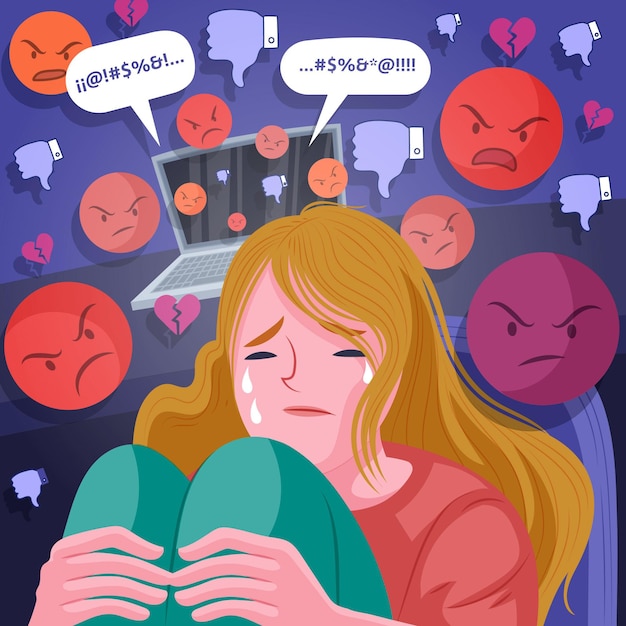
Introduction to Cyberbullying:

Cyberbullying, also known as cyberharassment, is an electronic form of violence or abuse. Online bullying is another term for cyberbullying. Cyberbullying takes place online in social media, forums, or gaming where people can access, engage in, or exchange information. Sending, publishing, or forwarding disruptive, damaging, misleading, or mean stuff about someone else is considered cyberbullying. It may involve shame and humiliation caused by revealing intimate or private knowledge about another person. Cyberbullying can sometimes quickly turn into illegal and criminal activity.
Why is Cyberbullying the Worse?
Individuals’ comments, photographs, posts, and uploads on social media and digital platforms are accessible to outsiders as well as friends and family. An individual’s online material, both personal and any highly offensive, mean, or hurtful content against them, provides a kind of permanent public record of their values, behavior, and attitude.
This public record can be thought of as an online reputation that can be accessed by teachers, employers, universities, clubs, and those that are currently or in the future doing research on that person. Any personal humiliating detail can stick around the victim’s life and events for way long. Its effect can be devastating to a person. Everyone engaged with cyberbullying risk having their online reputations harmed.
Women are the most harmed gender of cyberbullying. According to an alarming survey, approximately 35% of women worldwide are victims of some form of cyber harassment. Through the help of several studies, it was found that girls were targeted more than boys in cases of cyberbullying.
Effects of cyberbullying
When cyberbullying takes place, inappropriate comments, videos, or texts usually get exchanged with a large number of people. The vast majority of the people who are aware of the bullying can cause embarrassment. Cyberbullying victims also find it hard to feel protected. They feel helpless and insecure. Cyberbullying often undermines their self-esteem and self-worth, which may lead to depression.
Cyberbullying also targets people at their worst points. Bullying victims may feel unhappy with their own identities. As a consequence, they may tend to question their own worth and importance, leading to low self-esteem. Furthermore, most people advise turning off the device or turning off the phone while cyberbullying happens. Phones and computers are two of the most popular means of communication for them. Due to this, they feel stuck in a hole unable to seek help and ever use social media again as a networking tool.
The sheer negativity on many platforms today is alarming.
Click here to read an article on the effects of social media on teenagers.
Laws against Cyberbullying
So, online abuse is indeed a crime? The simple truth to that is, yes. There could be civil punishment for cyberbullying. The majority of countries have stalking or assault laws that explicitly include digital contact (both online & offline). Most law enforcement departments have cyber-crime teams, and Internet harassment is often more serious than physical stalking reports.
Take sexting, for example. In this case, individuals who send or receive sexts can be punished for distributing child pornography. Moreover, if the person in the photograph took the picture themselves and then shared it, they could be charged with the distribution of child pornography if they are a minor.
But cyber-bullying legislation is not specific to sexting. While there is no federal legislation explicitly addressing cyberbullying, if anyone is cyberbullied on grounds of race, ethnicity, sexuality, gender preference, disability, or religion, it may conflict with discriminatory abuse and federal civil rights.
As a result, some cases will end up in federal court. While others can require felony complaints and prosecutions for hate crimes, impersonation, stalking, and offenses under the Computer Fraud and Abuse Act (CFAA).
In addition to these wider laws, various states have their own laws and legislation on cyberbullying, which differ from state to state. StopBullying.gov, a government website, features a state-by-state map that outlines specific measures.
State-level Cyber-Bullying Laws
There is currently no federal legislation that specifically tackles bullying. Bullying is often confused with discriminatory harassment, protected by federal civil rights legislation enacted by the US Departments of Education and Justice. These regulations require educational institutions, regardless of the label used (bullying, hazing, or teasing), to handle behavior that is: Since the federal government has not enacted a national law against cyberbullying or anti-bullying, each state is responsible for drafting and implementing its own legislation. All fifty states have laws on harassment in force.
State regulations, as well as the standards for school districts, differ significantly. Let us take two examples, Ohio and South Dakota state.
For instance, Anti-bullying regulations in South Dakota include the following concept of bullying:
As described in Chapter 22-19A, Threats, harassment, stalking, physical assault, stealing, loss of property, any threatening use of data or computer software, written or verbal contact, or actions towards a student are all examples of bullying.
(1) Places a student in reasonable fear of harm to his or her person or damage to his or her property, and either
(2) Substantially interferes with a student’s educational performance; or
(3) Substantially disrupts the orderly operation of a school.
S.D. Codified Laws 13-32-15 (2012)
South Dakota anti-bullying laws cover off-campus conduct that is committed via computers or electronic devices regardless of time or place.
New York anti-bullying laws and regulations include the following definitions of harassment, bullying, and cyberbullying. Off-campus activity that causes or may foreseeably creates a risk of significant disturbance within the school community, where the conduct, threats, coercion, or harassment is foreseeable to enter school premises.
On the other hand, No. Ohio anti-bullying laws do not cover off-campus conduct. Ohio anti-bullying laws include the following definitions of bullying or harassing behavior:
“Harassment, intimidation, or bullying” means either of the following:
(a) Any intentional written, verbal, electronic, or physical act that a student has exhibited toward another particular student more than once and the behavior both:
(i) Causes mental or physical harm to the other student;
(ii) Is sufficiently severe, persistent, or pervasive that it creates an intimidating, threatening, or abusive educational environment for the other student.
Conclusion

A series of high-profile cyberbullying incidents have recently made the headlines, with the perpetrators facing felony charges. Cases of cyberbullying may rise and so colleges, societies, and law enforcement become more effective at detecting it. Meanwhile, advocates are urging the federal government to get more involved. They agree that schools should have specific guidelines for how to prevent cyberbullying while fostering empathy and compassion in the curriculum. Cyberbullying is a major problem that is only getting worse. As a result, parents must be vigilant in instilling digital awareness and etiquette in their children.
If you are a victim of cyberbullying, please be vocal about your story and get the necessary help. Confused about the first step? Check out Be-vocalized. Be-vocalized is a group of people who believe in assisting assault victims. We don’t charge a fee and work with our partner attorneys and law firms to help you get justice.
Image Courtesy: Unsplash, Freepik.









[…] Cyber-bullying is commonly prevalent in teens. Sending, publishing, or forwarding disruptive, damaging, misleading, or mean stuff about someone else online or offline using digital technologies is cyberbullying. […]